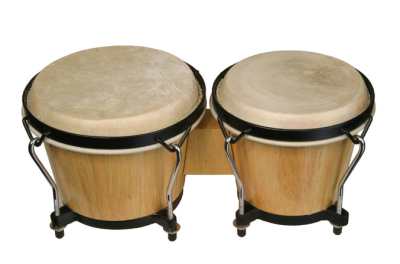Bongo Drums - Care & Tuning
Q: How do I put a new head, a new skin on my conga or bongo drum? A: Click here for instructions. Q: Tell me about tuning. A: Tune your (natural skin) bongos up before playing them, and down again when you're finished. If you don't, the weather may change quickly, and cause the heads to contract and split. Many of us have learned this the hard way. It's usually the macho head rather than the hembra. When tightening your heads, go about a quarter turn at a time, moving around the lugs clockwise to tighten, and counter-clockwise to loosen after playing. Keep a close eye on evenness, especially at the beginning, watching to ensure that the lugs are evenly tightened. If you turn the drum upright and place it on a very flat surface, you will be able to tell if one or more lugs are uneven. Tighten the drum up gradually, but rather than listening for a particular pitch, go for a feel. Use your ears; listen carefully and critically. The macho (male, or smaller) head will start to have a "pop" to it at one point, it sings, the tone seems to emerge effortlessly with a touch. (Note: Use caution if you're not sure. We won't replace the head for you if you miss the spot and tighten it until it breaks. ) The hembra is approximately a forth below the macho, perhaps not quite as tight. Long ago, before metal tuning lugs, when the heads were tacked on, the drums were played looser, but nowadays, as a solo instrument in a big amplified band, the pitch is much higher to increase projection and volume. Q: Should I put anything on the heads? Only if the heads feel really dry. Here's what you do: Put a bit (about a quarter sized portion) of almond oil or any good lotion with lanolin in the palm of your hand, then rub your hands together, and rub the lotion or oil into the drum heads. You can do this as often as the heads feel dry, to keep the leather supple, and not brittle Q: I have those little bongos with the tacked on heads. How do I tune them? A: Good question. The original bongo drums were like this. You can put them in front of an oven or an open fire, taking care not to put them so close that they burn. Players of old also used that canned heat or other heat source, or put the drums in the sun when possible. If you should want the drums tuned a little lower, wet your hands, and rub the moisture gently into the heads until you reach the desired looseness. These tuning techniques will also work with most other fixed tension (real skin) drums, such as tamborines, tars, etc. Q: Are plastic heads any good? A: It's a trade off, really. They don't have quite the richness and wamth of a real skin head, but they do require less maintenance, and are playable in all sorts of weather. Even some pros like Karl and Raul of Santana use REMO heads because of the extra projection and durability. The plastic heads have a high pitched overtone, which bothers some folks, but is not noticable in an amplified situation. It is nice to have a drum that's impervious to the weather, but it's also nice to have the richness and warmth of a real skin head. Q: What about using X-ray film for the macho head? I've heard they all do it in Cuba. A: We have heard about it, but haven't tried
it. A kind visitor from Cologne, Germany writes: "It works
very well and saves lot of money, no need to change the pitch
(as |

 Here's
our funniest one yet:
Here's
our funniest one yet: